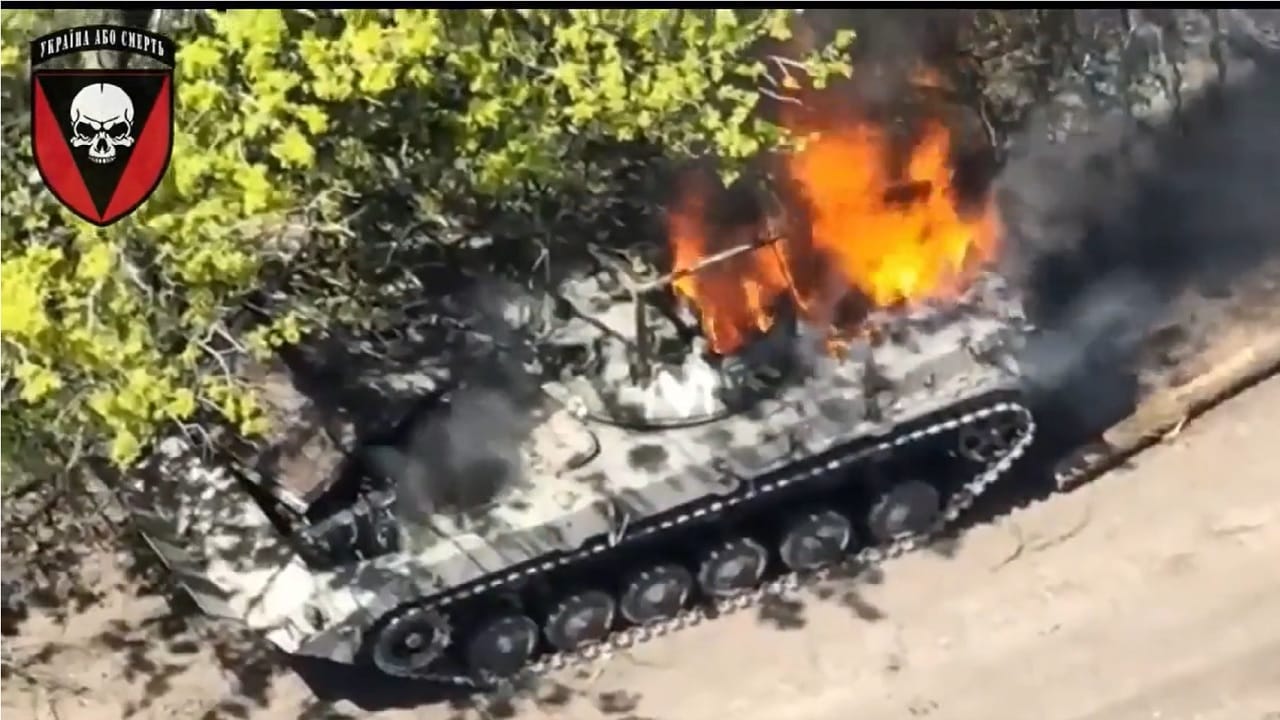Ukraine Weapons Tracker published a video this week depicting the destruction of a Russian BMP-2 infantry fighting vehicle near Donetsk Oblast.
According to the Twitter handle, this vehicle was taken out by Ukraine’s 72nd Mechanized Brigade.
Tank warfare has featured prominently in Russia’s invasion of Ukraine. Main battle tanks have proven vital to Kyiv’s and Moscow’s war efforts by offering protection and firepower.
While Moscow previously claimed to possess some of the most capable and advanced armored vehicles on the planet, its fleet has not performed well in Ukraine.
Some analysts believe Russia might have lost half its modern tanks, including its T-72 MBTs. The country’s stockpile of T-80 tanks might be depleted by as much as two-thirds. Many of these Russian MBTs were destroyed by anti-tank weapons, while others were captured by Ukrainian forces or simply left behind by ill-equipped Russian soldiers.
In an effort to replenish its dwindling tank force, Moscow has turned to storage units filled with antiquated equipment. Russia is hurting so badly from a lack of advanced MBTs that it has even turned to less combat-capable alternatives like the BMP (Boyevaya Mashina Pekhoty) amphibious infantry fighting vehicle. Equipped with a radiation-shielded interior, the Cold War-era BMP-1 was designed to fight alongside Soviet MBTs. These fighting vehicles also possessed a 73 mm gun and an anti-tank missile launcher, making them pretty formidable in their day.
Specs and Capabilities
A slightly improved variant was eventually designed by Russian engineers to improve the BMP’s capabilities.
As detailed by Army Recognition, “The 100 mm 2A70 rifled gun can fire 3UOF17 and 3OF32 high-explosive fragmentation rounds at a rate of 8 to 10 rds/min, or the 3UBK-10-3 with the 9M117 laser-guided anti-tank missiles. The 9M117 missile is able to penetrate between 650 and 700 mm of conventional steel armor. Russia has also developed the 9M117M and 9M117M1 fitted with a tandem warhead able to penetrate ERA (Explosive Reactive Armor). The missile has a firing range from 100 to 5,500 m.”
Following a limited initial production run of more than 300 vehicles between 1987 and 1994, the BMP-3 re-entered mass production in the early 2000s, according to Forbes. While the firepower of the newer BMP variants should be capable of taking out Ukrainian positions, the fighting vehicles have not performed well in the ongoing invasion.
How Have BMPs Fared in Ukraine?
Perhaps the BMP-3’s greatest design flaw is in its ability to carry troops. The tank’s crews have to dismount from the hatch of the hull roof instead of from the rear, which greatly slows down soldiers exiting the vehicle. According to Oryx, more than 700 BMPs have likely been destroyed over the last year. “366 BMP-2s with rapid-fire 30mm cannons …130 BMP-3s with both a 100mm and 30mm cannon … 59 BMPs for which the exact model couldn’t be identified” are among the list of vehicles taken out in Ukraine.
As Ukraine’s highly anticipated counteroffensive approaches, Moscow will undoubtedly turn to its surviving stockpiles of armored and fighting vehicles to secure additional advances. Considering the BMP’s track record in Ukraine, however, they are unlikely to provide the punch Moscow is hoping for.
#Ukraine: A Russian BMP-2 infantry fighting vehicle with a cope cage was destroyed by the Ukrainian 72nd Mechanized Brigade south of Mykilske, #Donetsk Oblast. pic.twitter.com/wMcpHY6Jlm
— ???????? Ukraine Weapons Tracker (@UAWeapons) May 7, 2023
Maya Carlin, a Senior Editor for 19FortyFive, is an analyst with the Center for Security Policy and a former Anna Sobol Levy Fellow at IDC Herzliya in Israel. She has by-lines in many publications, including The National Interest, Jerusalem Post, and Times of Israel. You can follow her on Twitter: @MayaCarlin.

